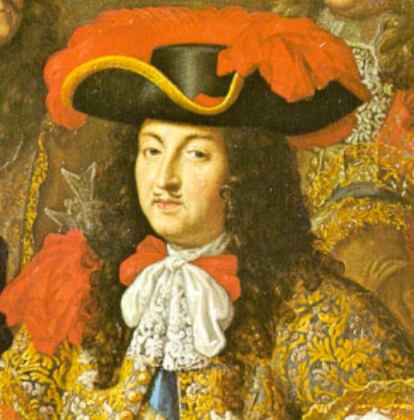Originally, the cravat was a simple piece of fabric wrapped around the neck in a careless knot but - as is often the case with fashion - it became more elaborate and more opportunities emerged. There was a tendency to take inspiration from how the military wore their clothing and this was indeed the case with the cravat as well. As it happens the cravat got its name from Croatian troops (serving Louis XIII and Cardinal Richelieu) - named cravates in French - who wore white pieces of cloth around their necks.
Another style adapted from the military was the steinkerk which got its name from the Battle of Steinkerk. The ends were folded over one another as one would when starting a braid and was then led through a buttonhole. The style gave off a dishevelled look which was quite intentional; allegedly the troops of the Battle of Steinkerk did not have time to properly tie their cravats. This became the favourite type of cravat at the French court and would remain so until the 1720's.
Quickly, the cravat spread from the Croatian soldiers to the French aristocracy to the French common people and from there out into Europe. Aristocrats had the luxury of choosing expensive materials and different knots while the working men managed with simply a piece of cloth.
 |
| Wooden cravat which was in the collection of Horace Walpole. It gives a very accurate description of how it looked |
Lace became quite a favourite among the nobility and as such it is often seen in portraits. Others were made from cambric, muslin or linen. To keep the expensive laces in place the cravat was tied with an aptly named cravat string; basically, a ribbon to tie around the cravat to keep it where it ought to be. In the 1680's these strings were gradually abandoned and the ends were allowed to hang loosely. This style remained in fashion for quite a while.
The early years of the 18th century the style of having the piece of fabric tied closely around the neck and was either buckled or buttoned in the back. To stiffen off the fabric a sort of cardboard was often added. Eventually, another piece of fabric - this time in black - was added to the "stock" as the style was called. This was usually accompanied by a lovely jabot which was basically frilled laces. This remained in style until the 1770's.
 |
| Stock buckle - used to tie the fabric tightly around the neck |
In the 1770's cravat made a comeback due to the so-called macaronis. These were young dandies who were often seen sporting a cravat after having completed their grand tour in Italy and thus it became the trend again.
The remnants of a cravat still exists in men's fashion today - only we call it a tie.
As seen in portraits:
 |
| Louis XIV, 1667 |
 |
| James II, 1686 |
 |
| Comte d'Angivillier wearing a "stock" and laced jabot |
 |
| An English gentleman |




No comments:
Post a Comment